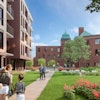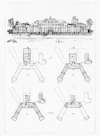Before we envision ourselves in this new living space, a brief look back at the building's history is in order. The Grace Dart Manor is a testament to Neo-Georgian architecture, also known as Classical Revival, which was popular in the early 20th century.
Proportions, balance, symmetry, and regularity in composition are among the key characteristics of Neo-Georgian architecture, easily noticeable in the main building that will be preserved and revitalized within the future Mellem Grace Dart.
In the past, Neo-Georgian constructions were generally clad in brick or stone, in shades of red, brown, and white. It's likely this color palette that inspired architect David Robertson Brown to choose multi-toned brown bricks as ornaments and to whitewash the red bricks, producing an effect that closely resembled stone. However, this contrast has since disappeared as the red bricks have regained their natural color.
In this vein, the ongoing revitalization project aims to protect the heritage character of the site by preserving the majority of the main building, including the main structure, the east and west wings, and the former nurses' residence. These preserved elements will house some of the future units and common areas of Mellem Grace Dart.

Henry James Dart was a Montreal pharmacist who volunteered to care for the less fortunate. He was the founder and former director of the small hospital "The Grace Dart Home" located on Saint-Antoine Street West in the Little Burgundy neighbourhood, the predecessor of Grace Dart Manor.
Henry James Dart (1847 · 1913)
In the late 1920s, the high demand for care led to a shortage of space in the small hospital on Saint-Antoine Street West. The administrators decided to build a larger facility.
On March 8, 1932, the first patients were welcomed to the newly relocated Grace Dart Manor on Sherbrooke Street East, during the Great Depression. This was made possible through fundraising and grants from the ministry related to charitable work for the less fortunate.
David Robertson Brown, architect, is widely recognized as the designer of Grace Dart Manor according to numerous sources. As one of the association's administrators at the time, David Robertson Brown was invited to consult with the medical staff and develop a functional plan for a building that could accommodate 100 beds, with the potential for expansion.
David Robertson Brown (1869 · 1946)
Reflecting on the milestones of a constantly evolving neighbourhood:
— 1850 · 1910: In the 19th century, the former parish of Longue-Pointe was a rural area, and its agricultural vocation persisted until the early 20th century, when urbanization began to develop more intensely to the south near the Saint Lawrence River. The agricultural division of the land is still perceptible in the current urban layout: the boundaries of the former rows now form the layout of Rue du Quesne and Avenues de la Pépinière and de Carignan.
— 1910 · 1960: The first half of the 20th century saw the rapid transition from a rural to an urban condition in the neighbourhood. At the time, the location was favored by educational and health institutions, attracted by areas distant from Montreal's economic activities for reasons of hygiene.
— 1960 · 1980: Throughout the second half of the 20th century, the residential environment around Grace Dart Manor developed. The 1970s were marked by the construction of the Olympic Park and Village, and major public domain and accessibility improvements were made, including the construction of the Cadillac metro station near the site.
— 1980 · 2023: Starting in the 1980s, the neighborhood continued to densify with numerous residential projects and townhouses appearing on parcels surrounding Grace Dart Manor, contributing to the creation of a truly mixed and active living environment where the new Mellem project is situated.
Mellem Grace Dart, set to open in the spring of 2025, is thus a testament to a rich and transformative past that we look forward to experiencing daily with a brand-new, dynamic community. If you too wish to contribute and stay informed about the next steps of this extraordinary project in East Montreal, click here.








